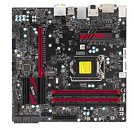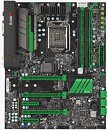Monday, February 11th 2019
SuperMicro Gearing for Launch of New Gaming-Grade Motherboards With PCIe Gen4 and DDR5 Wave
SuperMicro may not be household name in consumer motherboards right now, but they once were a decent alternative in the market - or so I've been told by people much more knowledgeable than me in that regard, as I never laid my hands on one. The company is now more known for its server products, where it has focused most of its attention in the past decade - an effort that gave it a good, third-place hold in that market. And if the company can command such a market share in a much more requirements-heavy environment such as the server market demands, then it's likely those design decisions and developments will find themselves trickling down to the consumer side in any sort of consumer, gaming-grade product the company decided to tackle.
To that end, SuperMicro is gearing up to re introduce themselves to the consumer market, accompanying the wave of new technologies coming to the market in a few years - namely, PCIe Gen 4 and DDR5 memory. The company seems to think that this will mark a perfect opportunity for a strong comeback to the consumer market - where they now only offer a handful of motherboard solutions for Intel's CPUs. One such example is the C9Z390-PGW motherboard, based on Intel's Z390 chipset - with its 10-phase VRM design, PLC chip for doubling of PCIe lanes, and 10 Gigabit Lan. But not only on said "typical" consumer motherboard techonologies will SuperMicro be delivering - if the company has its way, anything from 5G, IoT, Mission Learning and Artificial Intelligence can be incorporated for some use case or another on consumer-grade motherboards, thus providing an axis of penetration for SuperMicro - and its entire partner eco-system.The company is looking to leverage its IoT and server expertise that it has been cultivating in the last few years - with gaming grade products that will go up against the likes of ASUS Maximus and Gigabyte Aorus. Senior VP Vik Malyala told KitGuru that their company is also monitoring Ryzen's performance in the market, and reflected upon SuperMicro being one of the first companies to release Epyc-supporting motherboards. Perhaps we'll see the return of green to motherboards with a sexy tinge of environmentally-friendly operations.
Sources:
KitGuru, via TechSpot
To that end, SuperMicro is gearing up to re introduce themselves to the consumer market, accompanying the wave of new technologies coming to the market in a few years - namely, PCIe Gen 4 and DDR5 memory. The company seems to think that this will mark a perfect opportunity for a strong comeback to the consumer market - where they now only offer a handful of motherboard solutions for Intel's CPUs. One such example is the C9Z390-PGW motherboard, based on Intel's Z390 chipset - with its 10-phase VRM design, PLC chip for doubling of PCIe lanes, and 10 Gigabit Lan. But not only on said "typical" consumer motherboard techonologies will SuperMicro be delivering - if the company has its way, anything from 5G, IoT, Mission Learning and Artificial Intelligence can be incorporated for some use case or another on consumer-grade motherboards, thus providing an axis of penetration for SuperMicro - and its entire partner eco-system.The company is looking to leverage its IoT and server expertise that it has been cultivating in the last few years - with gaming grade products that will go up against the likes of ASUS Maximus and Gigabyte Aorus. Senior VP Vik Malyala told KitGuru that their company is also monitoring Ryzen's performance in the market, and reflected upon SuperMicro being one of the first companies to release Epyc-supporting motherboards. Perhaps we'll see the return of green to motherboards with a sexy tinge of environmentally-friendly operations.


31 Comments on SuperMicro Gearing for Launch of New Gaming-Grade Motherboards With PCIe Gen4 and DDR5 Wave
Hopefully they get a competent bios team
Probably just for more juice, just like my X470 board has 8pin + 4pin.
Not sure how Supermicro are looking to regain their marketshare with technologies that aren't commercially available... Hynix only announced their first working DDR5 module in November last year, and I very much doubt that Zen 2 will support it, so I'm not expecting to see DDR5 become widespread until at least 2020.
How can DDR5 work currently? Isn't the memory controller on the CPU? So wouldn't there be issues trying to run CPU's that obviously do not have such memory controller on a board using DDR5? And which DDR5 modules exist?
nope.
Today's CPUs are required to support DDR5 since they have their memory controllers integrated (back in the LGA775 days the memory controller was on the motherboard, which allowed motherboards to support new memory that the CPUs didn't, or even support multiple types of memory). Now, it's possible that AMD and Intel could respin their CPU designs to add DDR5 support, but they don't like supporting multiple memory types because that takes up extra space on the die, where space is already at a premium.
Zen 2 is supposed to be launching in the middle of the year, and it's conceivable that part could support DDR5, but AMD has made it clear that the AM4 socket is supposed to be around through 2020, and historically AMD has always changed sockets for a new memory type, which strongly suggests no DDR5 support. From Intel's side it's anyone's guess as their roadmap is a mess right now with 10nm their priority above everything else, so I'd say it's unlikely that they'll offer DDR5 support this year either.
Based on all of the above, I think we'll be lucky to see DDR5 memory (and support for it in other products) available to consumers before the end of this year, and I definitely don't see DDR5 taking the lion's share of the market before 2021.That story has been debunked far and wide.